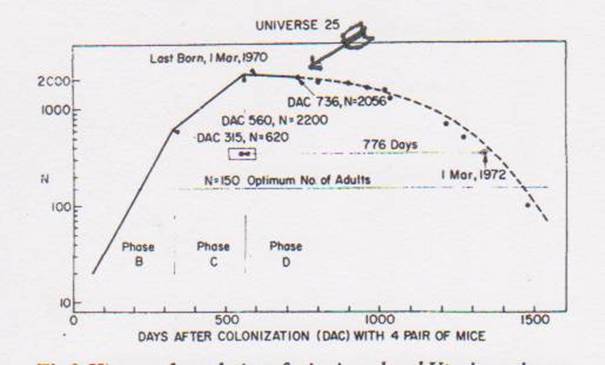
Once was a utopia for mice:
A couple of times over the years I have heard of a story of a man who raised some rodents. One source told me it was hamsters. Another told me it was rats. Over the years I made a number of internet searches in vain. Then, thanks to Google Scholar, I found a Youtube clip. http://www.youtube.com/watch?v=0Z760XNy4VM I looked at it on 6/13/14.
The clip describes raising a large number of mice in an interconnected array of spaces. The population grew exponentially, growth slowed, stabilized and then the population collapsed. The experiment was terminated when there were only a few very old mice left, long past reproductive age. It seemed very familiar. That is the pattern I see everywhere.
The study was done to demonstrate the effect of crowding. There was always enough food, water, space and nesting material. Yet they died out. The scientist was John B. Calhoun. He attributed the fall in numbers to excessive social contact.
But there was a problem. The population basically rose, stabilized and then died. Elsewhere what I see regularly is the population rise, fall, rise again and then go extinct. I had to see the original data. It was published as John Calhoun Death Squared: The Explosive Growth and Demise of a Mouse Population Proceedings of the Royal Society of Medicine vol. 66, January 1973 page 80.
Here is the time course of the population size:

History of population of mice in a closed Utopian universe.
Broken line represents an estimate of numbers made about 700 days
after colonization on the basis of observed mortality to
that time. Observed points after Day 1000 are slightly
lower than projected due to removal of about 150 mice for other studies.
A final point was added to the graph for Day 1471 when the population had
decreased to 100. At final editing of his paper on November 13, 1972 (Day 1588) the inexorable decline brought the population to 27 (23females and
4 males, the youngest of which exceeded 987 days of age)
Sure enough, there is no notch, to transient decline in numbers. But notice something very odd. Just at the critical point, where the numbers should have fallen the first time, he changed the way he was counting the mice. (Indicated by my arrow.) Now this should not be a problem. Instead of counting live mice, he counted dead ones and subtracted from what he knew was already in the cage. This change was made a hundred days after the last live mouse had been born. But it does seem odd.
Any way you cut it, of course, the results are in flagrant disagreement with Malthus. The population simply does not grow until the resources are exhausted.
Calhoun’s interest was in the behavioral effect of crowding. And sure enough he got some odd behavior. Dominant males fought other males. Subordinate males fought each other. A group of males he dubbed “the beautiful ones” dropped out of social interaction altogether. They ate, drank slept and groomed and nothing else. If they were taken from that environment and placed in an uncrowded environment with reproductively competent females they took no interest in the females.
Since Calhoun set up the experiment to study the effect of crowding, and found an effect it would take a braver man that I to say he was simply wrong, that his change in accounting introduced a systematic error that concealed the hallmark pattern of growth – decline – growth – death or that his behavioral changes had more to do with epeigentic changes than with simply bumping into other mice. And indeed, he could induce, and a colleague John Hill could induce, similar behavior by crowding with smaller numbers and with surgically produced brain lesions.
But the fact is that there was no time when all the nesting sites were filled. And there was no occasion except for the very large population in which extinction occurred. I cannot claim his study to be strong confirmation of what I have done in fruit flies, but it tends more to support than to deny.
There have been 68 visitors over the past month.